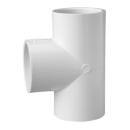Difference between revisions of "Tee"
m (added links) |
MCRKilljoy (talk | contribs) |
||
| Line 1: | Line 1: | ||
[[Image:Tee.gif|right|thumb|130px| A 1" SCH-40 PVC Tee]] | [[Image:Tee.gif|right|thumb|130px| A 1" SCH-40 PVC Tee]] | ||
| − | A '''tee''' has 3 [[ | + | A '''tee''' has 3 [[solvent weld]] (or [[female threads|threaded]] in the case of steel) openings. Steel tees also come in weld-in types, but these are mainly for industrial use. [[Flanged]] or [[grooved]] tee fittings are used for huge pipes.<br> |
These are arranged in a planar arrangement, each skewed 90* from the last. This looks a bit like the letter "T", which is where the fitting derives it's name. | These are arranged in a planar arrangement, each skewed 90* from the last. This looks a bit like the letter "T", which is where the fitting derives it's name. | ||
Revision as of 00:40, 9 December 2016
A tee has 3 solvent weld (or threaded in the case of steel) openings. Steel tees also come in weld-in types, but these are mainly for industrial use. Flanged or grooved tee fittings are used for huge pipes.
These are arranged in a planar arrangement, each skewed 90* from the last. This looks a bit like the letter "T", which is where the fitting derives it's name.
Tees are useful for connecting 2 pipes into one, such as connecting two chambers to one valve or connecting many valves to a common trigger.
A more advanced use of tee fittings is as the basis for both barrel- and chamber-sealing piston valves. The valve itself is constructed inside the tee, and the outlets are connected to the chamber, barrel and pilot valve.
